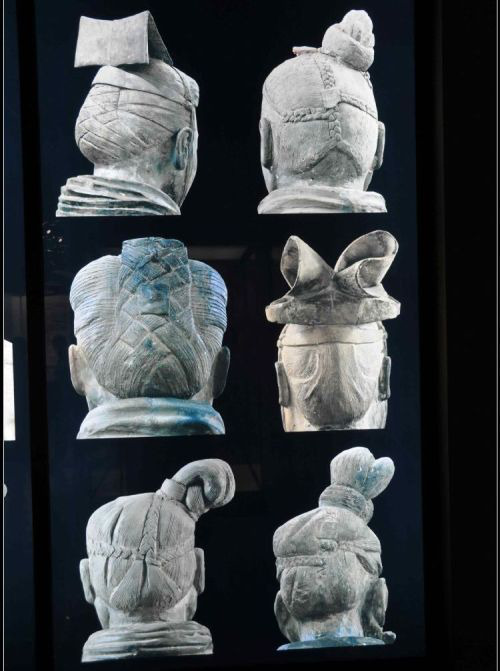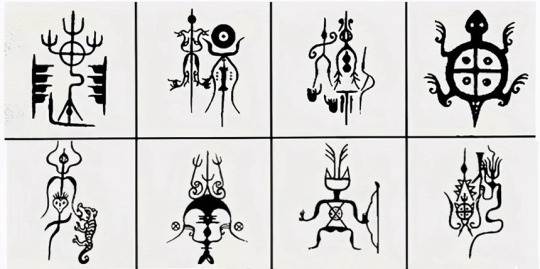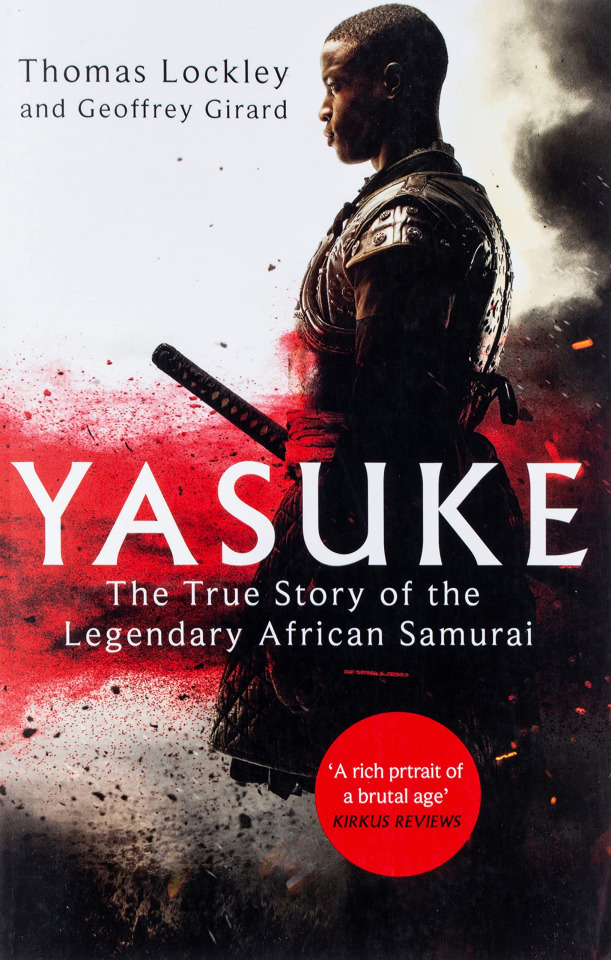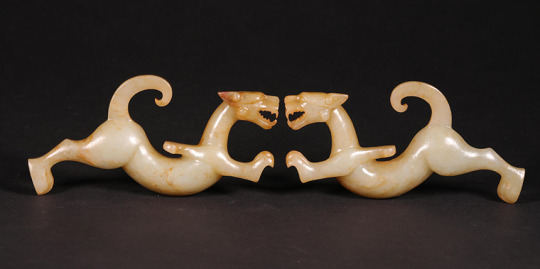#warring states
Text
i literally spend at least 2 hours a week just looking at various pictures of the terracotta army. utterly entranced. look at the details in the hair. you'd never see ANY of this when they're lined up in formation, but they're there.

theres about 8000 of these guys down there, no two faces are alike. they're works of art. they're the manifestation of a cruel despot's delusions of grandeur. a talisman against the terrible inevitability of death, both pathetic and strangely pitiful. like watching a child clinging to his blanket, begging you not to turn off the light. they were a bunch of insignificant clay statues from a side chamber that was so small and unremarkable, no one bothered to write down the location. they were modelled after real people. their only purpose was to serve qin shi huang in the afterlife, so he could reign in heaven as he did on earth. now the emperor is just a ghost and his pawns are immortal. my dad and i visited them in the dead of winter, on a weekday, just so we wouldn't have to deal with tourists like us. the place had easily 500 people--not including the ones below ground. we traveled to xian via the old "green skin" diesel train. there are faster means, like highspeed rail but dad insisted i try the authentic way, the same way he would have traveled when he was my age it was also like, a quarter of the price but im sure that had nothing to do with it! back in the 80s carriages would get so packed people had to have their luggage passed in via the windows. as we chugged along, i read my book and my dad made us cup noodles. car is just a shortened version of "carriage", the word is the same but the mechanism is different. it's the same in chinese. i think if i told someone from the warring states period i could travel from the Kingdom of Qi to Qin in just four hours with my metal carriage, i'd be laughed out of town--or accused of being a spy and sentenced to 'death by carriage.' we hopped off the train at 4am and took a different "carriage." the taxi driver joked; "basically every dynasty put their capital in xian, stick a shovel anywhere and you'll turn up some national treasure or another." i wonder what it would have felt like to be a farmer digging a well and then out pops a remarkably realistic human head. statistical analysis show the soldier's faces bear a strong similarity to people living in the region today. the taxi stopped in front of a jewellery-hawking tourist trap and refused budge an inch until we went inside. did you know the terracotta soldiers were originally multi-coloured and painfully gaudy, just like the greek marbles? they were made assembly-line style. the arms and legs were made from the same workshops that made clay plumbing pipes and roof tiles. for quality control, the artisans were required to stamp their names. the workers who built these tombs were executed shortly afterwards, because only dead men can be trusted with secrets. qin shi huang's mausoleum is unlikely to be excavated in my father's lifetime, or mine, not unless i'm willing to take a BIG ONE for the team... instead of the tomb, they built some kind of qin shi huang-themed theme park next to it. not only was it tacky as hell the entrance fee was like $50. we went to the museum and i looked at bronze tools and pottery shards for three hours. look why can't we just crack the thing open i can't be the only one here whos dying from curiosity what if we all just took turns digging
#qin shi huangs terracotta army#warring states#qin dynasty#thinking about Her...<3 bronze tools and pottery shards <3#my writing
1K notes
·
View notes
Photo

百步穿杨
- Yang Youji
Shoot an arrow through a willow leaf a hundred steps away.
This chengyu describes an excellent marksman, equivalent to calling them a “deadeye.” Records suggest that during the Warring States period (475-221 BCE), a man named Yang Youji was challenged by King Zhuang of Chu to shoot a dragonfly without killing it, which he managed by shooting an arrow through its left wing. Yang, it was said, could shoot a willow leaf from a hundred paces away without fail. Yang became famous for his martial arts skills, and this chengyu was born.
#youji#yang youji#quote#chinese#bow and arrow#archery#femme#warring states#ancient china#martial arts#marksmanship
338 notes
·
View notes
Text
A 2,200-2,500-year-old cemetery just discovered in China has yielded hundreds of artifacts including a small arsenal of splendidly preserved Bronze weapons that look like they have barely been used. They date to the tumultuous Warring States period, when various warlords vied for power in the region, with overall victory going to Ying Zheng, the King of Qin, unifying China for the first time.
18 notes
·
View notes
Text

There was a a letter from Nobukatsu addressed to Ieyasu that made news last April, but I didn't catch this news then. Thankfully the article is archived in a lot of places (many news sites these days paywall old articles, or delete them altogether).
The letter is dated the Tenth Month of Tenshou 13 (November 1585), and it mentioned how Ieyasu had sent his vassal Ishikawa Kazumasa to Hideyoshi to negotiate. The rest was interpreted to be Nobukatsu trying to persuade Ieyasu to stand down and not try to raise arms against Hideyoshi, assuring Ieyasu that Hideyoshi will regard Ieyasu's concerns carefully in the proceedings.
At this point Hideyoshi is already the Kanpaku, having received the title and rank in the seventh month of the same year.
The news report also narrates that history recorded Ieyasu still persisting in trying to fight Hideyoshi, despite this mediation. Ieyasu only ceased his plans and agreed to surrender because a massive earthquake hit in the 11th month of the same year, causing large-scale devastation in multiple provinces.
Many castles collapsed because of the earthquake, and there's further complications because of landslides, tsunami, and fires that occurred in the aftermath. With all the domain lords likely tied up trying to do damage control in their territories, there's no way to start a war at this time.
Nobukatsu visited Ieyasu in the first month of the next year (February 1586), and Ieyasu expressed his intention to agree to surrender then.
#oda nobukatsu#artifact#letter#tokugawa ieyasu#japanese history#samurai#sengoku#sengoku jidai#sengoku era#sengoku period#warring states era#warring states period#warring states#toyotomi hideyoshi#hashiba hideyoshi
37 notes
·
View notes
Text
Ancient Chinese Surnames: Privilege of Nobility and Ritual Feature
Ancient Chinese Surnames: Privilege of Nobility and Ritual Feature
The practice of regulation through the awarding of titles points to another feature of Warring States administration derived from earlier ritual practices: the granting of family names. While still subject to debate on many points, our current understanding of Shang and Zhou naming practices suggests that the patronym (xing) had not existed under the Shang, but had first appeared under the Zhou…

View On WordPress
#ancient China#anthropology#Chinese culture#Chinese history#Chinese surnames#old China#Shang dynasty#Taoism#traditional society#Warring States#Zhou dynasty#姓
193 notes
·
View notes
Text
Poll/Question for the Faction Paradox fandom, since the Book of the War says one thing, but then Warring States said another. I was waiting through to the end of Warring States to see if the retcon would be mentioned, but it was not resolved or even seemed to notice the discrepancy.
#polls#tumblr polls#doctor who#faction paradox#Cousin Octavia#Warring States#The Book of the war#faction paradox spoilers#possibly#I'm voting romance and the healers edited her memeories without her knowing
3 notes
·
View notes
Text
Yasuke
Book review:

It's 1579 and the end of Japan's warring age appears imminent. Few warlords remain who have not been crushed or enthralled by the might of Oda Nobunaga, the great unifier. Making inroads are firearms, European fashion and Christianity. Into this world steps Yasuke, a towering, dark skinned African bodyguard who ascends to Nobunaga's inner circle. More than a biography, this is a detailed account of martial, upper-echelon, pre Edo Japan.
Taking place amidst some of the most exciting and violent years of Japanese history, this is a riveting textbook camouflaged as a biography. Yasuke was an intriguing oddity. A singular black African soldier, he arrived at a time when Europeans were rare and himself nearly unique. He rises to become a confidant of the most powerful warlord the country had seen and officially gains elevation to samurai, complete with stipend and household. He's also a linguistic genius going from fresh off the boat, barely heard of Japan, and within a year he is conversing with the defacto head of state, not only without embarrassing himself but well enough that Nobunaga would specifically sought him out for discourse.
Yasuke's story is the backbone to two other major elements that contribute to the bulk of the 400 pages of content. Digressions are frequent and sometimes expansive. These cover relevant character backstories, the state of the world, the Jesuit order, scientific advances, ocean travel, regional history, local history, cultural notes and other circumstantial information. The other major element is Oda Nobunaga. His looming presence and monumental impact mean that Yasuke is sometimes an excuse for a massive infodumping of Nobunaga's manoeuvrings, political intrigues, regional factions, personal histories and warfare. This last point is not to be taken lightly. Another review goes as far as saying that "blood and gore ooze from the pages". Perhaps an exaggeration but it does viscerally convey the martial activity prevalent to Yasuke's world.
Yasuke is the work of Thomas Lockley of Nihon University College of Law, Tokyo, in collaboration with Geoffrey Girard. Described by some sources as a debut novel, it certainly feels as if great care and attention have been lavished into its details. It was first published in 2019 as African Samurai. Arguably a much better and very literal title but perhaps confusable with the separate cult fiction property, Afro Samurai. The latter being an action slasher in a generic Edo-ish setting with light cyber and supernatural genre blending. More recently, an older, fictionalised Yasuke stars in a Netflix OVA adaptation, again featuring an altered history and very anachronistic Edo.
Shelf: 210.48 YAS
Yasuke : the true story of the legendary African samurai.
by Thomas Lockley and Geoffrey Girard.
Paperback edition.
London : Sphere, 2020.
ISBN: 9780751571592 (paperback)
472 pages : illustrations, map ; 20 cm.
First published in Canada?, 2019 as African Samurai by Hanover Square Press.
Includes bibliographical references and index (pages [457]-472).
#review#jcentral#non-fiction#history#biography#sengoku jidai#sengoku period#oda nobunaga#warring states#samurai#warfare#religion#christianity#jesuits#review 2023 04#new 2023 04
2 notes
·
View notes
Text
Qin Shi Huang did a lot to make China what it is today, but what truly makes him great is that he united the world because his soldiers wore pants
3 notes
·
View notes
Text

Palestinian activists get their message across on Londons iconic Tower Bridge landmark- one of the cities most historic buildings. We need a ceasefire now.
#london#palestine#free palestine#israel#gaza#free gaza#فلسطين#jerusalem#i stand with palestine#israel is a terrorist state#israeli war crimes
63K notes
·
View notes
Text
Help Hamza get his family out of gaza.
#free palestine#free palestine 🇵🇸#palestine#i stand with palestine 🇵🇸#israel is a genocidal state#israel is committing genocide#palestine will be free#free gaza 🇵🇸#israel is a terrorist state#gaza genocide#rafah#jews for palestine#palestine news#news on gaza#gazaunderfire#stand with gaza#war on gaza#free gaza#gaza strip#gaza#gazaunderattack#save gaza#israelis are terrorists#israel is a war criminal#israel is an apartheid state#israel is evil#fuck israel#boycott israel#israhell#tel aviv
35K notes
·
View notes
Text




#feminist#social justice#free palestine#palestine#free gaza#current events#bangladesh#solidarity#israel is a terrorist state#israel is committing genocide#israel is evil#israel is a war criminal#palestinian liberation
29K notes
·
View notes
Text

#palestine#free palestine#gaza#free gaza#fuck israel#israel crimes#israel war crimes#israel is a terrorist state#israel#ceasefire now#end the genocide
22K notes
·
View notes
Text


BDS has called for an official boycott of Eurovision2024
Everyone...you know what to do
[ID 1: text on a black background reading: "Boycott Eurovision: Artwashing Israel's #GazaGenocide". The Eurovision logo is edited such that red barbed wire appears over the heart in the center.
ID 2: a tweet from "PACBI - BDS movement" @/PACBI reading:
We call for the boycott of #Eurovision2024". We urge all participating broadcasters, national competitors, finalists, production crews, and viewers to boycott the contest following the refusal of the organizers @/EBU_HQ to ban genocidal Israel. #BoycottEurovision2024
End ID.]
#free gaza#israel#gaza strip#gazaunderattack#gaza#israel is a terrorist state#genocide#jerusalem#free palestine#palestine#news#palestine news#war on gaza#war news#northern gaza#eurovision#eurovision 2024#boycotting#boycott israel#boycott#boycott eurovision#bds
16K notes
·
View notes
Text
The true origin of the sandal warming story??
I'm going to start by quoting a story to you. It can be found in "Tales of the Samurai", which was translated by Miyamori Asatarou. You can read the entire text in this link here, but here's the relevant segment (I apologize for length):
While his lordship thus soliloquized, Heishiro, the sandal-bearer—Makabé Heishiro as he was called from his birthplace, Makabé in Hitachi, a surname being a luxury unknown to the third estate—waited without. Having adjusted his master’s footgear there was nothing more to do till he should come out again. But presently Heishiro observed that the snowflakes fell and lay somewhat thick on his valuable charge. He hastened to brush them off with his sleeve, but more flakes fell, and again the geta (clogs) were covered with icy particles.
“This will never do,” he said to himself. “His lordship disdains to wear tabi (socks) even in the coldest weather, deeming it a mark of effeminacy; should he place his bare feet on these damp geta he will assuredly catch cold. I must keep them warm and dry for him.”
So the good fellow in the kindness of his simple heart took up the heavy wooden clogs, and putting them in the bosom of his garment next to his skin, continued his patient waiting.
[...]
Heishiro had just time to put the geta straight on the large stone step at the entrance before the double doors slid open fight and left and Masamuné appeared, young, imperious.
He slipped his feet on to the geta. How was this? They felt warm to his touch! How could that be in such freezing weather? There could be but one explanation. That lazy lout of a sandal-bearer had been using them as a seat—sitting on the honourable footgear of his august master! The insufferable insolence, of the fellow!
In a passion at the supposed insult he caught the offender by the nape of his neck, and shook him violently, exclaiming between his set teeth, “You scoundrel! How dared you defile my geta by sitting on them! You have grossly insulted me behind my back! Villain, take that....”
Catching up one of the clogs which he had kicked off, he struck the poor servitor a heavy blow between the eyes, which caused him to reel stunned and bleeding to the ground.
Does this story sound familiar?
If you know about Nobunaga well enough to have heard of the sandal story, you might already noticed this is a little weird.
If you are not familiar with it, I tell you here that this is a standard narrative commonly associated with Nobunaga and Hideyoshi. Barring the oddly specific detail about not wearing socks for it being "effeminate" (it's a first for me), just swap out the name of "Masamune" for Nobunaga and the sandal bearer with Hideyoshi and you get the gist of it.
In the above story, Masamune's anger could not be calmed and the sandal bearer left his service. However, the sandal bearer then eventually became such a celebrated monk of high standing. Masamune ended up inviting him to be the abbot of Zuigan-ji, the temple he had recently restored, without knowing that the master was the same sandal bearer he got angry at.
In the Nobunaga version, Hideyoshi was able to prove his innocence, which led to Nobunaga gaining appreciation of his efforts and promoting him.
Once I did a little investigation on the story of Hideyoshi warming Nobunaga's sandals. In the oldest source I was able to discover, the story was originally nothing at all. Hideyoshi kept the sandals warm, yes, but it was very likely what sandal bearers were just supposed to do and no big fuss was made about it. Nobunaga had appreciated Hideyoshi's care for horses, not what he did with the sandals.
The sandals that Hideyoshi warmed in the source I found were zouri, straw woven sandals. The story I quoted above talked about a geta, which are wooden platformed sandals (sometimes translated as "clogs"). The Nobunaga and Hideyoshi story that were in fictional adaptations or websites indeed flip flop between the sandals in question being zouri or geta. Clearly there is a problem here somewhere.


I believe I have finally found the actual origin of the sandals story, the dramatic one that includes an angry master being angry and accusing the sandal bearer of having sat on the sandals.
The story is narrated in the official website of Engaku-ji, an affiliate Rinzai Zen temple. It was actually the story of a revered Zen master, whose name was Houshin Shousai (or Shouzai) 法身性西.
Master Houshin was born in Makabe 真壁 district in the year 1189, and his name was originally Heishirou 平四郎. The lord he served was one Makabe Tokimoto 真壁時幹. You see now why the sandal-bearer in the above story was named the way that he was?
The narrative was similar to the one from Professor Miyamori's story. Heishirou warmed his lord's sandals, but Tokimoto accused him of having sat on the sandals and threw it at his head (as seen in the "Masamune" story above). Disheartened by this, Heishirou then quit his service and became a monk. He left for China to study Zen, and when he returned to Japan, he became the abbot of Enpuku-ji 円福寺. It wasn't until centuries later that Date Masamune restored Enpuku-ji, and it's now better known as Zuigan-ji 瑞巌寺 (the temple actually kept both names, and its official full name is Shoutou Seiryuuzan Zuigan Enpuku-ji 松島青龍山瑞巌円福禅寺).
Supposing this story was true, then it would appear that people down history just "stole" it and reapplied it to whomever they please. It's actually not about Masamune or Nobunaga or some other iconic Sengoku bushou (who are presumably "more interesting"). The "good ending" of the Nobunaga story had been apparently stolen from another narrative about the shogun Tokugawa Iemitsu and Sakai Tadakatsu (I talked about it in my post).
Once again, this is why I always try to be careful with "just so" stories from the internet. It's fine to use them in fiction, as these has become "established tropes" by now and nobody would be mad if you use them when writing novels or fanfiction.
However, in terms of actual historical truth, I don't take them as fact unless I can verify it in reasonably reliable sources.
#long post#sengoku fake news#date masamune#japanese history#sengoku period#sengoku#samurai#oda nobunaga#toyotomi hideyoshi#hashiba hideyoshi#warring states period#warring states era#sengoku era#warring states
9 notes
·
View notes
Text
Hu Fu, Tiger Tally, User Authentication Tool in Ancient China
Hu Fu, Tiger Tally, User Authentication Tool in Ancient China
Tiger tally, Hu Fu or Bing Fu, is a time-tested user authentication tool in ancient China. This antique gadget represented a carved zoomorphic figure split in two halves that had to be matched. Inside the halves, a pattern or password inscription was cut out, so that the parts were complemented by each other. The shapes of the Tiger tallies varied and did not always correspond to the name,…

View On WordPress
#ancient China#Asian art#Chinese art#Chinese history#Chinese miniatures#Chinese warfare#虎符#Han dynasty#hu fu#tiger tally#Warring States#Zhou dynasty
70 notes
·
View notes
Text

i can’t believe this is happening… i’ve been thinking of the al-shifa siege for the past five six days and it has literally made me sick. when will this end?
#free gaza#free palestine#gaza#gaza genocide#i stand with palestine#israel is a terrorist state#israel is a war criminal#israhell#save gaza#stand with gaza
18K notes
·
View notes